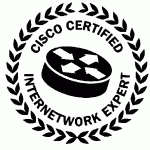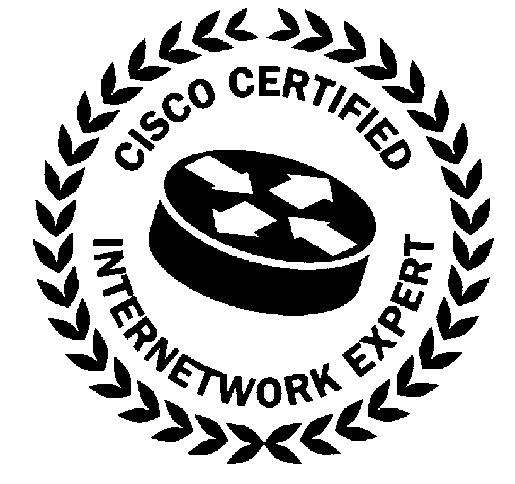
It seems like a fair number of people enjoy reading a “CCIE Story” – the tale of how somebody got their CCIE certification. Perhaps these are popular because the reader can see that normal people just like them do non-special things and achieve success, or because it gives them ideas on how to approach their study and execution of the exam? Or maybe we just enjoy reading stories.
I’ve shared my own story a few times in person, and the lab itself has changed a lot since I took it. But what the heck – you can have it anyway, and maybe there’s something amusing in there for you to take away.
The CCIE Written
I think I took the CCIE Routing & Switching written exam in late mid 2000. It was still colloquially known as the Drake Test (see this post for an explanation), and was highly regarded – it was a badge of honor among network geeks to pass the CCIE written exam. I always found this rather curious, because while it had some nasty elements, it also had some absolutely DUMB content, even then. I think I can talk about it pretty safely here since it has moved on significantly in the last 12 years and the things I will mention are not, to my knowledge, still in the exam. If anybody ever doubts that technology moves quickly, this should seal the case for you.
To put the exam in context, you have to consider IP as being the new kid on the block, relatively speaking. Token Ring and 10base2 were still common place; many people did not understand VLSM; switching was still being deployed by customers to replace hubs, and so forth. Troubleshooting skills were significantly lacking at that point too. So with that said, here are some examples of the types of questions which I think – with today’s knowledge – should be laughably easy. The actual exam was in multiple guess format, but I’ll spare you (and me) from making up sample answers.
Example question 1

Q: In the above diagram, R1 is sending a packet destined for R3. What is the destination MAC address on the Ethernet frame as it arrives at R2 at point B?
So far, so easy, right? At some other point in the exam, you’d find the following.
Example question 2
Q: In the above diagram, R1 is sending a packet destined for R3. What is the source MAC address on the Ethernet frame as it leaves R2 at point C?
Then maybe if you were lucky, you might get a question like the one below.
Example question 3

Q: In the above diagram, R1 is sending a packet destined for R3, but there is a collision on the Ethernet segment between R2 and R3. Which router is responsible for retransmitting the data?
I would imagine that for most of my readers, the questions above barely caused you to stir from your coffee. How about Token Ring Routing Information Fields (RIFs)? I always advised people to learn how to decode Token Ring RIFs. Why? Because (a) it was actually useful if you had TR running, but mostly (b) because the CCIE Written at the time would typically have 3-5 questions on Token Ring RIFs, all of the kind below
Example question 4
0830.014B.0642.0320
Given this RIF (see exhibit), what is the correct path and direction for the RIF?
The problem with these questions was that if you didn’t know how to decode them, you had a 1 in 4 or 1 in 5 chance of guessing (depending on how many options they offered), and worse, because there would be 3-5 questions like this, you’d likely lose a bunch of points. Once you realize the the first 16 bits are information fields (including a direction bit) and the rest are split in to 12-bit and 4-bit pairs representing ring number and bridge number respectively, these were a (relatively) easy few points and you’d be dumb not to get them.
If you’re really bored, Cisco still has an online Token Ring RIF decoder tool; copy the RIF above and give it a try!
Other Defunct Topics
Along with the Token Ring questions, the exam also covered a few topics that have since (I believe) all been dropped: Appletalk, DECnet, IPX/SPX, NetBIOS, ISDN, X.25 and DLSW. Oh how times have changed.
Multiple Choice(s)
One of the interesting (perhaps) points about the exam at this time was that Cisco was fond of using questions that did not specify how many of the answers were correct. I’ve not seen that done in a long time, but when you think about it’s a particularly good way to test because in a case where you need to select 3 out of 5 answers, you can usually spot 2 that are obviously incorrect and know that the other 3 must be right. The old written exam however liked to use the format “Select all correct answers”. I have to respect that, but it made it a bit more challenging, as that could be anywhere from 1 to 5 of them that were right!
Was It Easy?
No, but by knowing certain things you could certainly make it easier. This was especially important given that there were a couple of famed questions where there was either no right answer or, in one case, the correct answer was listed twice!
If you’re over 30, think back to how much you knew about IP at age 18 – probably not that much, I’d guess. But ask an 18 year old who is interested in network today, and I’ll bet they know an awful lot. The entry level of IP knowledge has increased dramatically over time, as is bound to happen as it becomes more common. The CCIE Routing and Switching Written Exam was written at a time when IP was not commonly known, when other protocols like IPX were equally commonly deployed, and things were arguably simpler on one level (but the protocols less well developed, natch). So for its time, no, it wasn’t easy, but it’s clear that for the topics that are still common now, it seems absurdly trivial.
How Did You Study?
The hard way. There weren’t many CCIE-level books to choose from at the time. The market was starting to grow for CCNP level books, but CCIE study was less common. So I looked at the CCIE Routing & Switching Written Exam Blueprint, which lists out all the topics they can cover, got what books I could that seemed relevant, e.g.
- Jeff Doyle’s “Routing TCP/IP, Volume I” (still a fabulous reference book, and at the time the first and only book to explain the algorithms behind EIGRP)
- Radia Perlman’s “Interconnections“
- Caslow’s “Bridges, Routers and Switches for CCIEs“
Basically I read an awful lot, and tried things out on routers.
In 2012 we’re now on v4.0 of the CCIE Routing & Switching Written Exam (350-001), and it looks nothing like the one I took back in 2000. If you are considering taking the exam, you should of course check out the v4.0 Blueprint (requires CCO login for some reason). There are a lot more options now for studying too – many more books to help you learn the relevant topics. I’d say this was a bad thing on one level, but on the flip side, the exam has kept pace with technology and remains above the average level of other networking exams, so however you gather the information to take the exam, it’s certainly still a challenging exam to pass.
And How Many Attempts Did You Need to Pass the Written?
One. That said, you should still feel sorry for CCIEs because we have to re-certify every 2 years, which means taking a Written Exam again. I made the mistake once of walking into a recert exam having assumed that my existing knowledge was enough, and not realizing that the blueprint had changed. Oops – fail. I also took a recert exam at Cisco Live one year with no study (it was free – be silly not to give it a shot), and missed by a few points. Most of us are likely to need to study for that re-certification exam just as somebody new to the CCIE Written has to study. And I suspect the CCIEs hate it even more than the CCIE candidates do!
As a consequence of taking the exam every couple of years though, I have watched the progression of topics over the years and it’s nice to know that apart from a few years in the early 2000s, the exam has not stood still. Despite the challenges this gives for re-certification, I like that because it keeps the certification current and valuable.
Next Steps
So with the Written Exam out of the way, and it was time to schedule the Lab Exam and start studying hard with real equipment!
I’ll talk more about that phase of the journey in Part 2 of my CCIE Story.




Leave a Reply